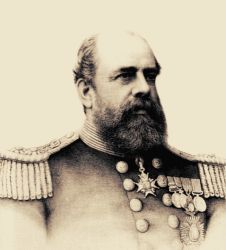Alas! Now o’er Britannia there hangs a gloom,
Because over 400 British Tars have met with a watery tomb;
Who served aboard the “Victoria,” the biggest ship in the navy,
And one of the finest battleships that ever sailed the sea.
And commanded by Sir George Tyron, a noble hero bold,
And his name on his tombstone should be written in letters of gold;
For he was skilful in naval tactics, few men could with him cope,
And he was considered to be the nation’s hope.
’Twas on Thursday, the twenty-second of June,
And off the coast of Syria, and in the afternoon,
And in the year of our Lord eighteen ninety-three,
That the ill-fated “Victoria” sank to the bottom of the sea.
The “Victoria” sank in fifteen minutes after she was rammed,
In eighty fathoms of water, which was smoothly calmed;
The monster war vessel capsized bottom uppermost,
And, alas, lies buried in the sea totally lost.
The “Victoria” was the flagship of the Mediterranean Fleet,
And was struck by the “Camperdown” when too close they did meet,
While practising the naval and useful art of war,
How to wheel and discharge their shot at the enemy afar.
Oh, Heaven ! Methinks I see some men lying in their beds,
And some skylarking, no doubt, and not a soul dreads
The coming avalanche that was to seal their doom,
Until down came the mighty fabric of the engine room.
Then death leaped on them from all quarters in a moment,
And there were explosions of magazines and boilers rent;
And the fire and steam and water beat out all life,
But I hope the drowned ones are in the better world free from strife.
Sir George Tyron was on the bridge at the moment of the accident
With folded arms, seemingly quite content;
And seeing the vessel couldn’t be saved he remained till the last,
And went down with the “Victoria” when all succour was past.
Methinks I see him on the bridge like a hero brave,
And the ship slowly sinking into the briny wave;
And when the men cried, “Save yourselves without delay,”
He told them to save themselves, he felt no dismay.
’Twas only those that leaped from the vessel at the first alarm,
Luckily so, that were saved from any harm
By leaping into the boats o’er the vessel’s side,
Thanking God they had escaped as o’er the smooth water they did glide.
At Whitehall, London, mothers and fathers did call,
And the pitiful scene did the spectators’ hearts appal;
But the most painful case was the mother of J. P. Scarlet,
Who cried, “Oh, Heaven, the loss of my son I’ll never forget.”
Oh, Heaven! Befriend the bereaved ones, hard is their fate,
Which I am sorry at heart to relate;
But I hope God in His goodness will provide for them,
Especially the widows, for the loss of their men.
Alas! Britannia now will mourn the loss of her naval commander,
Who was as brave as the great Alexander;
And to his honour be it fearlessly told,
Few men would excel this hero bold.
Alas! ’Tis sad to be buried in eighty fathoms of Syrian sea,
Which will hide the secret of the “Victoria” to all eternity;
Which causes Britannia’s sorrow to be profound
For the brave British Tars that have been drowned.
Foundering of H.M.S. Victoria
Loss of Admiral Tryon and 360 Officers and Seamen off Tripoli
We have now particulars of the lamentable naval catastrophe, which aroused the deepest sorrow and evoked the warmest sympathy of Her Majesty and of her humblest subjects. Baron Reuter’s agent at Beyrout sent word to London. last Monday that the following details concerning the loss of H.M.S. Victoria had been received there from Tripoli :-
“At half-past two o’clock on Thursday afternoon, June 22, the squadron was formed in two parallel lines, distant the one from the other about six cable lengths; each vessel maintaining a distance of two cable lengths from the next. The Victoria led the line nearest the shore; the Camperdown heading the corresponding line. The squadron at this time was about seven miles off Tripoli.
Vice-Admiral Sir George Tryon gave the order to convert the formation into that of single file. To effect this change each line of vessels had to turn inwards upon itself. In executing that manoeuvre the Camperdown collided with the Victoria, striking her in the bows. The ram of the former struck the leading vessel with tremendous force, crashing right into her centre. It was at half-past three o’clock that the catastrophe occurred. Sir George Tryon turned the Victoria’s
head towards the land with the object of endeavouring to run her ashore. It was evident that the damage inflicted left the admiral no other alternative. Orders were given to bring on deck all the sick and all the prisoners. The whole crew were also ordered on deck.The water, however, poured so rapidly into the enormous breach made by the ram of the Camperdown that the prow of the Victoria seen began to settle down. The Vice-Admiral, seeing that the vessel was doomed, ordered a ‘sauve qui peut.’
All then precipitated themselves into the sea. with the exception of Vice-Admiral Sir George Tryon, who remained alone on the bridge. The Victoria, continuing to sink head foremost, assumed a perpendicular attitude, her stern standing for a few moments straight up out of the water. The vessel then turned right over, and sank ten minutes after the collision. As she went down, two tremendous explosions were heard.
The loss of life is stated as follows: Vice-Admiral Sir George Tryon, 22 officers, 337 men. The Camperdown sustained serious damage and made considerable water, but was kept afloat by the closing of her watertight compartments and by working the pumps. After necessary repairs she will proceed to Malta. The Victoria lies in seventy fathoms of water, and it is believed that it will be quite impossible to raise her.”
The Foundering of the ill-fated Victoria was graphically described by the Port Said correspondent of the Standard from information gathered from the cruiser Barham –
“Sir George Tryon, who was on the bridge at the moment of the accident, at once gave directions for the collision mat to be placed over the damaged parts, and signalled for assistance to the rest of the fleet. The order was obeyed with the utmost promptitude, every vessel sending boats to aid in the rescue of the crew.
Before they could reach the spot, however, the Victoria, which had been filling rapidly on the side on which she was struck, suddenly turned right over, the steel masts striking the water with tremendous force. The movement continued, until, to the consternation of the rest of the squadron, the great vessel was seen to be keel uppermost, the twin screws revolving rapidly all the time. As she began to sink, many of the crew were observed to be crawling up the sides of the hull on to the keel.
To add to the horror of the scene the boiler exploded with two loud reports as the ship went under water.
The boats of the squadron picked up as many of the men as was possible, but the enormous suction caused by the sinking of the great ironclad drew down with her even the strongest swimmers.
Admiral Tryon was last seen on the bridge, giving orders with the utmost coolness and courage. It is said that he refused the offer of a life-belt from the coxwain, telling the man to look after his own safety.”
The Penny Illustrated Paper and Illustrated Times, 1st July 1893
Notes
 Vice-Admiral Sir George Tryon KCB (left) was one of the most outstanding naval officers of his generation. Unfortunately he was also a domineering individual who expected his commands to be obeyed to the letter. So, when he ordered his fleet to perform a turning manoeuvre that would inevitably lead to a collision, nobody dared question it until it was too late.
Vice-Admiral Sir George Tryon KCB (left) was one of the most outstanding naval officers of his generation. Unfortunately he was also a domineering individual who expected his commands to be obeyed to the letter. So, when he ordered his fleet to perform a turning manoeuvre that would inevitably lead to a collision, nobody dared question it until it was too late.
Steaming towards the Syrian coast in two parallel columns 1,200 yards apart, Tryon ordered each column to make a U-turn towards eachother so as to make two columns close together and sailing in the opposite direction. His Staff Commander, Thomas Hawkins-Smith, pointed out that the ships would need to be at least 1,600 yards apart to complete the manoeuvre successfully. Tryon acquiesced, but later told his Staff Lieutenant to close the distance to 1,200 yards.
 Flags were hoisted to signal the Admiral’s orders to the fleet. Tryon was an expert in fleet handling, and fond of ordering unorthodox formations to keep his officers on their toes, so if any of his subordinates thought the orders strange they trusted him to know what he was doing. Rear-Admiral Markham, leading the second column in HMS Camperdown, began to semaphore that he had not understood the signal. However, the impatient Tryon signalled “What are you waiting for?” – a public rebuke that stung his second-in-command into immediate action. The doomed ships began to turn towards each other.
Flags were hoisted to signal the Admiral’s orders to the fleet. Tryon was an expert in fleet handling, and fond of ordering unorthodox formations to keep his officers on their toes, so if any of his subordinates thought the orders strange they trusted him to know what he was doing. Rear-Admiral Markham, leading the second column in HMS Camperdown, began to semaphore that he had not understood the signal. However, the impatient Tryon signalled “What are you waiting for?” – a public rebuke that stung his second-in-command into immediate action. The doomed ships began to turn towards each other.
Not until the last moment did the captains attempt to tighten their turns and avoid a crash. It was too late. Camperdown’s ram pierced Victoria’s starboard side, making a huge hole about 12 feet below the waterline. The other ships in the fleet began to lower their boats, but Tryon countermanded this not realising how seriously Victoria was damaged. The ship was steered towards the shore in an effort to beach her, but she listed ever more to starboard until suddenly she sank head-first into the sea, with her propellers still turning. The order to abandon ship came too late for many of the crew to save themselves and they went down still at their posts.
This was an era when Britannia was supposed to rule the waves. Tryon had managed to sink one of Her Majesty’s most impressive warships on a sunny day in perfect sailing conditions. Rather than face the shame of the inevitable court-martial he chose the honourable course and went down with his ship. 357 sailors went down with him.
Further Reading
- The “Victoria” and “Camperdown” Catastrophe – Article about the collision by a former naval officer
- HMS Victoria – Wikipedia page about the ship and its demise
- HMS Camperdown – Some photos of life aboard Camperdown in the 1890’s
Books
- Admirals in Collision – Richard Hough’s investigation of this famous historic incident

You have my heartfelt gratitude. I had been reading an account of the demise of HMS Victoria and my mood was sombre. Then, out of the blue it appeared; I couldn’t believe my eyes, “Poem by William McGonagall commemorating the loss of the Victoria.”
The perfect antidote to any disaster must surely be its commemoration by a man who remains arguably the worst poet in the world. In that respect, his gems have stood the test of time and have never been found wanting. His matchless style of poetry could transform the most tragic of events. Inspired by this poem I have retrieved and dusted down my copy of McGonagal’s works and look forward to hours spent reacquainting myself with The Special One. Thank you for this wonderful website.
Now picture an aged old mother
as she sits by her cottage door,
knitting socks for one she holds close to her heart.
Who she soon expects back on shore.
When they tell her his ship hit and foundered.
She says “My God that can’t be true,
for it’s only this morning I had a letter which said ‘I’ll be home in a day or two'”
When they tell her his grave is the water
she falls with a cry to the ground.
For she’d lost the best son that a Ma ever had,
When the flagship Victoria went down.